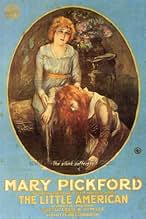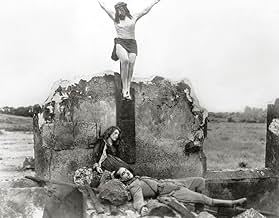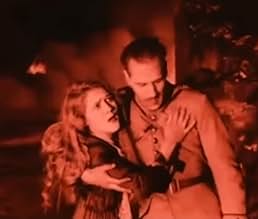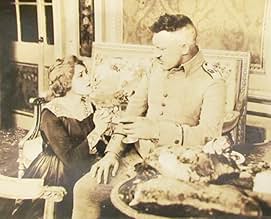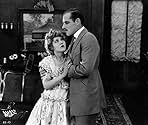IMDb-BEWERTUNG
6,3/10
773
IHRE BEWERTUNG
Füge eine Handlung in deiner Sprache hinzuA young American has her ship torpedoed by a German U-boat but makes it back to ancestral home in France, where she witnesses German brutality firsthand.A young American has her ship torpedoed by a German U-boat but makes it back to ancestral home in France, where she witnesses German brutality firsthand.A young American has her ship torpedoed by a German U-boat but makes it back to ancestral home in France, where she witnesses German brutality firsthand.
Wallace Beery
- German Soldier
- (Nicht genannt)
Olive Corbett
- Nurse
- (Nicht genannt)
Lucile Dorrington
- Nurse
- (Nicht genannt)
Clarence Geldert
- Submarine Commander U-Boat 21
- (Nicht genannt)
Carl Gerard
- Reverend
- (Nicht genannt)
Robert Gordon
- Wounded Soldier
- (Nicht genannt)
Gordon Griffith
- Child
- (Nicht genannt)
Empfohlene Bewertungen
This film is blatantly an anti-German propaganda film to which audiences flocked because America declared war on Germany a few months before its release. It's very effective even today, as I found myself despising the Germans for their actions, which included killing civilians and raping some women. Mary Pickford plays the title character, uncharacteristically a grown woman instead of a child she played in most of her films during the silent era. She is wooed by German-American Jack Holt and French-American Raymond Hatton when war breaks out in 1914. The Germans are depicted as being overly brutal.
There was one scene that made me laugh, when the Germans break the door down to enter her aunt's home. Mary tells them in deadly ernest while waving a small American flag, "Gentlemen - you are breaking into the home of an American citizen - I must ask you to leave." The Germans, led by Walter Long, roared with laughter too. I couldn't decide if it was comic relief or if you were suppose to sympathize with Mary.
I rather enjoyed the film for what it was. It was paced well by DeMille and the acting was fine but typical of early silents. Walter Long made a good heavy - he can sneer with the best of them.
You may notice in the cast list some famous names (Wallace Beery, Ramon Novarro, etc.) without character names. You never actually see these actors, but they are known to have been in the film from various writings, including DeMille's autobiography.
There was one scene that made me laugh, when the Germans break the door down to enter her aunt's home. Mary tells them in deadly ernest while waving a small American flag, "Gentlemen - you are breaking into the home of an American citizen - I must ask you to leave." The Germans, led by Walter Long, roared with laughter too. I couldn't decide if it was comic relief or if you were suppose to sympathize with Mary.
I rather enjoyed the film for what it was. It was paced well by DeMille and the acting was fine but typical of early silents. Walter Long made a good heavy - he can sneer with the best of them.
You may notice in the cast list some famous names (Wallace Beery, Ramon Novarro, etc.) without character names. You never actually see these actors, but they are known to have been in the film from various writings, including DeMille's autobiography.
THE LITTLE AMERICAN was the second of two movies Mary Pickford and Cecil B De Mille made together in 1917. These would be the only films they would collaborate on. While they were successful at the box office, Pickford and De Mille constantly clashed over who was in charge. At that time, Mary Pickford was better known than De Mille and made far more money. For economic reasons, Paramount sided with De Mille and Pickford had no choice but to go along. You would never guess this from seeing the movie.
At that point in his career, De Mille was still finding his way. TLA was one of his first big spectacles and it shows he already had the knowledge to handle large forces. Mary had just finished THE POOR LITTLE RICH GIRL which would typecast her for the rest of her career as the "little girl" character. Mary was 25 when she made her 2 De Mille pictures and it's something of a rarity to see her playing characters her actual age. When LITTLE AMERICAN started shooting, the U. S. was still neutral but entered into World War I before it was finished.
Mary plays a young American woman with 2 suitors. One is a French American, the other is a German American. This is July 1914. A month later when the war breaks out, each suitor goes to fight for his respective country. Mary inherits a chateau in France and arrives just in time to have it invaded by German troops including her German suitor. Her French suitor supervises a counter attack. The chateau is bombarded and Mary and her German suitor, who deserts, flee onto the battlefield and hide out in a church. Of course, Mary is rescued, but what about her boyfriend?
The print used for this restoration is a 35 mm copy from De Mille's original private print and in very good condition with proper color tints, original title cards,. The restoration was done by the UCLA Film & Television Archives under the auspices of the Mary Pickford Foundation. The accompanying score by Adam Chavez was newly composed for this release. This official home video release from VCI is coupled with the 1912 Biograph short, A LODGING FOR THE NIGHT and an informational booklet...For more reviews visit The Capsule Critic.
At that point in his career, De Mille was still finding his way. TLA was one of his first big spectacles and it shows he already had the knowledge to handle large forces. Mary had just finished THE POOR LITTLE RICH GIRL which would typecast her for the rest of her career as the "little girl" character. Mary was 25 when she made her 2 De Mille pictures and it's something of a rarity to see her playing characters her actual age. When LITTLE AMERICAN started shooting, the U. S. was still neutral but entered into World War I before it was finished.
Mary plays a young American woman with 2 suitors. One is a French American, the other is a German American. This is July 1914. A month later when the war breaks out, each suitor goes to fight for his respective country. Mary inherits a chateau in France and arrives just in time to have it invaded by German troops including her German suitor. Her French suitor supervises a counter attack. The chateau is bombarded and Mary and her German suitor, who deserts, flee onto the battlefield and hide out in a church. Of course, Mary is rescued, but what about her boyfriend?
The print used for this restoration is a 35 mm copy from De Mille's original private print and in very good condition with proper color tints, original title cards,. The restoration was done by the UCLA Film & Television Archives under the auspices of the Mary Pickford Foundation. The accompanying score by Adam Chavez was newly composed for this release. This official home video release from VCI is coupled with the 1912 Biograph short, A LODGING FOR THE NIGHT and an informational booklet...For more reviews visit The Capsule Critic.
With the Great War ravaging Europe as this film was made, it's a clear signal of patriotism from star Mary Pickford as she depicts the feisty "Angela". She's from wealthy stock and on her birthday is being courted by French "Count Jules" (Raymond Hatton) and by her slight favourite, the Prussian soldier "Karl" (Jack Holt). Before she has to make any choices, though, both head to their respective homes to fight. Shortly thereafter, she decides to travel to her aunt's home in France only for her liner to be torpedoed and for her to find that when she eventually arrives at her stately pile that the Bosch are intent on billeting there and behaving abominably too. Her American status gives her a degree of protection so long as she stays out of the conflict, and her stiff-necked friend "Karl" is amongst the occupiers, but when their cruelty to the house's staff and to an elderly gent shock her to the core, she decides that she can no longer stay on the fence. What now ensues sees her bravely attempt to help the Allied forces at great peril not just to her, but to her friend who would try to keep her as alive as his upbringing would permit! That merely invites a trial for espionage and treason and a firing squad for both of them looms... Can they find a way to escape the bullets? This is an effective propaganda tool, this film, illustrating just how ghastly the enemy were; how indiscriminate their violence was inflicted and how generally boorish and superior they were. Pickford and Cecil B. DeMille clearly wanted to ram that point home to domestic audiences and on that front they are quite effective. It really could have done with some more light, but even dingy as it is it delivers quite a potent analysis of uniformed thuggery tempered by conflicted romance and a semblance of human decency. It has it's zealous moments - from all sides, and in it's way it is quite a tough film to watch as though not graphic in terms of photography, it is in terms of psychology. It has a clear message to send and is worth a watch, I'd say.
According to his autobiography The Little American is the film that Cecil B. DeMille wanted to make with Mary Pickford. Both were strong supporters of the Allied cause in World War I. But Adolph Zukor wanted a box office draw with a western so A Romance Of The Redwoods was done first. DeMille envisioned The Little American as part of his contribution to the propaganda war effort. And Pickford was well known for her bond tours with her husband Douglas Fairbanks.
The Little American has Mary Pickford a daughter of the a US Senator and being courted by two men, German-American Jack Holt who receives orders to return to the Fatherland for an officer's commission in the newly declared war and French diplomat Raymond Hatton similarly ordered home. Pickford's family has a château in France and she travels there to be a nurse. But her ocean liner is torpedoed like the Lusitania and she eventually gets there.
But as it turns out the château is in German occupied territory and she's asked to do a little espionage. And who do you think is among the Germans occupying, none other than Holt.
As this was a film that DeMille himself labels a contribution to the war effort a lot of it can be dismissed. Pickford was her heroic best as The Little American. Some aspects of the real life Edith Cavell story are incorporated here with a lot more happy ending.
As for the German atrocities. They'd have to wait until the next war when Hollywood couldn't make up what they did in real life.
The Little American has Mary Pickford a daughter of the a US Senator and being courted by two men, German-American Jack Holt who receives orders to return to the Fatherland for an officer's commission in the newly declared war and French diplomat Raymond Hatton similarly ordered home. Pickford's family has a château in France and she travels there to be a nurse. But her ocean liner is torpedoed like the Lusitania and she eventually gets there.
But as it turns out the château is in German occupied territory and she's asked to do a little espionage. And who do you think is among the Germans occupying, none other than Holt.
As this was a film that DeMille himself labels a contribution to the war effort a lot of it can be dismissed. Pickford was her heroic best as The Little American. Some aspects of the real life Edith Cavell story are incorporated here with a lot more happy ending.
As for the German atrocities. They'd have to wait until the next war when Hollywood couldn't make up what they did in real life.
In its own time, this effective and often compelling wartime melodrama used the talents of Mary Pickford and a young Cecil B. DeMille in support of the Allies in the first world war. It works well in itself, and it might be even more worthwhile now, for a generation that can view the events of that era more impartially, in order to draw some broader lessons from it.
Pickford plays Angela, "The Little American", a young woman courted by a German and a Frenchman who are both living in America. This familiar setup soon becomes much more serious when the war breaks out, and the two young men return to Europe and the battlefield, with Pickford's character soon joining them in the midst of the turmoil and terror of the conflict. The ensuing story occasionally has some points in common with the Valentino/Rex Ingram classic "The Four Horsemen of the Apocalypse", though with a generally more hopeful tone.
The first half has a particularly excellent sequence that depicts a submarine attacking a passenger liner. It works very well both dramatically and thematically. In particular, the light and motion of the sub's searchlight darting erratically through the darkness, so that its crew can survey the results of their attack, produces a chilling effect that is probably more effective than any amount of screaming could have been. The sequence works convincingly in portraying the barbarous, inhuman nature of attacks on civilian targets, and it also demonstrates the emptiness of the excuses used to justify them.
That is probably the strongest sequence, but the main story in the château also has some worthwhile material. The German soldiers are largely portrayed as subhuman, but this is balanced to a large degree by the character of Karl (Jack Holt) and his inner struggle between his sense of duty and his sense of justice. Holt and Pickford work well together, and Raymond Hatton, though not getting as much screen time, also makes good use of his opportunities.
With the delightful Pickford as the star, and DeMille already showing his ability to film set pieces effectively, this must have been very persuasive in its original purpose of strengthening support for the Allied cause. But now it can serve a different, and possibly more important, purpose. The harrowing experiences of Angela and the other characters are effective in demonstrating how quickly the fabric of human society can tear apart when military victory becomes all-important. While less ambitious and less well-known than the best-known of the classic movies that came out of the first world war, "The Little American" works well, and it is well worth the time to watch.
Pickford plays Angela, "The Little American", a young woman courted by a German and a Frenchman who are both living in America. This familiar setup soon becomes much more serious when the war breaks out, and the two young men return to Europe and the battlefield, with Pickford's character soon joining them in the midst of the turmoil and terror of the conflict. The ensuing story occasionally has some points in common with the Valentino/Rex Ingram classic "The Four Horsemen of the Apocalypse", though with a generally more hopeful tone.
The first half has a particularly excellent sequence that depicts a submarine attacking a passenger liner. It works very well both dramatically and thematically. In particular, the light and motion of the sub's searchlight darting erratically through the darkness, so that its crew can survey the results of their attack, produces a chilling effect that is probably more effective than any amount of screaming could have been. The sequence works convincingly in portraying the barbarous, inhuman nature of attacks on civilian targets, and it also demonstrates the emptiness of the excuses used to justify them.
That is probably the strongest sequence, but the main story in the château also has some worthwhile material. The German soldiers are largely portrayed as subhuman, but this is balanced to a large degree by the character of Karl (Jack Holt) and his inner struggle between his sense of duty and his sense of justice. Holt and Pickford work well together, and Raymond Hatton, though not getting as much screen time, also makes good use of his opportunities.
With the delightful Pickford as the star, and DeMille already showing his ability to film set pieces effectively, this must have been very persuasive in its original purpose of strengthening support for the Allied cause. But now it can serve a different, and possibly more important, purpose. The harrowing experiences of Angela and the other characters are effective in demonstrating how quickly the fabric of human society can tear apart when military victory becomes all-important. While less ambitious and less well-known than the best-known of the classic movies that came out of the first world war, "The Little American" works well, and it is well worth the time to watch.
Wusstest du schon
- WissenswertesFilm debut of Ramon Novarro.
- PatzerWhen Angela is returning to her bedroom after taking off the German commander's boots, the shot of her approaching the door is shown twice.
- Zitate
Count Jules De Destin: Since you are determined to stay, Mademoiselle, you may render France a great service.
- Alternative VersionenThe George Eastman House version in their Motion Picture Study Collection has an uncredited piano score and runs 76 minutes.
- VerbindungenFeatured in The House That Shadows Built (1931)
Top-Auswahl
Melde dich zum Bewerten an und greife auf die Watchlist für personalisierte Empfehlungen zu.
Details
- Erscheinungsdatum
- Herkunftsland
- Sprache
- Auch bekannt als
- The Little American
- Drehorte
- 2000 De Mille Drive Los Feliz, Kalifornien, USA(Home of Cecil B. De Mille in Laughlin Park, shown in the first shot right after the opening credits)
- Produktionsfirma
- Weitere beteiligte Unternehmen bei IMDbPro anzeigen
Box Office
- Budget
- 166.949 $ (geschätzt)
- Laufzeit
- 1 Std. 20 Min.(80 min)
- Sound-Mix
- Seitenverhältnis
- 1.33 : 1
Zu dieser Seite beitragen
Bearbeitung vorschlagen oder fehlenden Inhalt hinzufügen

